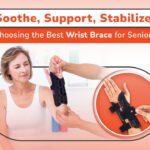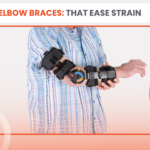Arthritis is a common condition affecting millions worldwide, causing joint pain, stiffness, and reduced mobility. When it strikes the knee, it can significantly impact daily activities, from walking to climbing stairs. Fortunately, knee braces offer a non-invasive and effective solution for managing arthritis pain. They provide much-needed support, enhance mobility, and help reduce inflammation, allowing individuals to maintain an active lifestyle.
Choosing the right knee brace for arthritis can be a game-changer, but with so many options available, it can be overwhelming. At Heal Medical Supply, we understand how crucial it is to find the perfect fit for your needs. In this guide, we’ll walk you through the different types of knee braces, how to choose the right one and the benefits they offer in relieving arthritis pain. Whether you’re dealing with mild discomfort or severe knee arthritis, this comprehensive guide will help you make an informed decision for optimal pain relief and improved knee function.
Let’s get started on finding the best knee brace to help you get back to your active life.
Understanding Arthritis and Knee Pain
Arthritis is a broad term that refers to inflammation of the joints, causing pain, stiffness, and reduced mobility. When it affects the knee joint, it can significantly impact a person’s ability to perform everyday tasks. Two primary types of arthritis commonly affect the knees: osteoarthritis and rheumatoid arthritis.
- Osteoarthritis (OA): The most common form of arthritis, OA, occurs when the cartilage in the knee joint gradually wears down over time. This results in bones rubbing against each other, causing pain, swelling, and stiffness. OA typically affects older individuals, but it can also develop in younger people due to injury or overuse.
- Rheumatoid Arthritis (RA): Unlike OA, RA is an autoimmune disease where the body’s immune system attacks the joints, causing inflammation and damage. RA can affect both knees simultaneously and often leads to severe pain, deformities, and significant loss of function.
Regardless of the type, arthritis in the knee can lead to ongoing pain, swelling, and discomfort, which can severely limit mobility and quality of life. That’s where knee braces come in.
Knee braces help by providing external support to the affected joint, reducing the strain on the knee and alleviating pain. They also help to stabilize the knee, prevent further damage, and improve overall function. With the right knee brace, individuals suffering from arthritis can experience improved mobility and an enhanced quality of life, allowing them to continue doing the things they love.
Types of Knee Braces for Arthritis
Choosing the right knee brace for arthritis is essential for pain relief, joint support, and improved mobility. Different types of knee braces offer varying levels of support based on the severity of arthritis and individual needs. Here are the most common types:
- Compression Knee Sleeves – Ideal for mild arthritis, these braces improve circulation, reduce swelling, and provide gentle support.
- Wraparound Knee Braces – Easy to put on and adjust, offering moderate support for individuals with mild to moderate knee pain.
- Hinged Knee Braces – Designed for enhanced stability, these braces support weakened joints and help prevent excessive movement that may worsen arthritis pain.
- Unloader Knee Braces – Best for osteoarthritis, these specialized braces shift weight away from the damaged part of the knee, reducing pain and improving mobility.
- Custom vs. Off-the-Shelf Braces – Custom knee braces provide a personalized fit for severe arthritis, while off-the-shelf options offer affordability and convenience.
Selecting the best knee brace depends on your pain level, lifestyle, and medical recommendations. A well-fitted knee brace can make a significant difference in managing arthritis and maintaining an active lifestyle.
How to Choose the Right Knee Brace for Arthritis
Finding the best knee brace for arthritis depends on your pain level, mobility needs, and lifestyle. Here’s what to consider:
- Severity of Arthritis – Mild arthritis may only require a compression sleeve, while severe cases benefit from unloader or hinged braces.
- Support Level – Choose a brace with the right stability, from basic compression to advanced joint support.
- Fit & Comfort – A properly sized brace prevents slipping and discomfort while ensuring maximum relief.
- Material & Breathability – Lightweight, moisture-wicking materials enhance comfort for daily wear.
- Doctor’s Recommendation – Consult a healthcare professional for the best knee brace for your specific condition.
Benefits of Using a Knee Brace for Arthritis
Arthritis in the knee can make everyday movements difficult, causing pain, stiffness, and instability. A knee brace is a simple yet effective solution that helps manage arthritis symptoms, allowing you to stay active and comfortable. Here’s how a knee brace can benefit you:

1. Pain Relief
Knee braces reduce the strain on affected joints by redistributing weight and providing structural support. Unloader knee braces, in particular, help shift pressure away from the damaged area, reducing pain and discomfort during movement. Compression braces also help alleviate soreness by improving circulation and reducing inflammation.
2. Improved Stability & Joint Support
Arthritis can weaken the knee joint, making it prone to instability and sudden giving way. Hinged knee braces and wraparound braces offer reinforced support, preventing excessive movements that could lead to further damage or injury. This added stability makes walking, standing, and climbing stairs much safer and more comfortable.
3. Reduced Swelling & Inflammation
Inflammation is a common symptom of arthritis, leading to swelling and stiffness in the knee. Compression knee sleeves help improve blood flow, reducing swelling and promoting faster recovery after activity. This can be especially helpful for individuals who experience morning stiffness or swelling after prolonged movement.
4. Enhanced Mobility & Flexibility
By reducing pain and stiffness, knee braces allow for greater ease of movement. Whether you’re going for a walk, exercising, or performing daily tasks, the right knee brace can help you move more freely without fear of discomfort or instability.
5. Joint Protection & Long-Term Support
Using a knee brace can help slow the progression of arthritis by preventing excessive wear and tear on the joint. Custom knee braces or off-the-shelf options designed for arthritis provide long-term protection, reducing stress on the knee and minimizing further cartilage breakdown.
Read More: Knee Brace for Osteoarthritis: How It Can Improve Your Quality of Life.
Tips for Proper Use and Care of a Knee Brace
Using a knee brace correctly ensures maximum pain relief, support, and durability. Follow these essential tips to get the most out of your knee brace:

1. Wear Your Knee Brace Properly
- Ensure the brace fits snugly but not too tight—it should provide support without restricting circulation.
- Position the brace correctly so it stabilizes the knee joint without slipping or bunching.
- Follow your doctor’s or physical therapist’s recommendations on when and how long to wear it.
2. Know When to Wear It
- Use a knee brace during activities that put stress on your knee, such as walking, exercising, or standing for long periods.
- Some braces, like compression sleeves, can be worn throughout the day, while hinged or unloader braces may be used only when needed.
- Avoid wearing the brace while sleeping unless recommended by a healthcare professional.
3. Keep Your Knee Brace Clean
- Wash fabric braces regularly to prevent sweat buildup, odors, and skin irritation.
- Hand wash with mild soap and cold water, or follow the manufacturer’s cleaning instructions.
- Allow the brace to air dry completely before wearing it again—avoid high heat, which can damage materials.
4. Check for Wear and Tear
- Inspect your knee brace regularly for signs of wear, such as fraying straps, loose hinges, or stretched elastic.
- Replace worn-out braces to maintain proper support and effectiveness.
- If the brace becomes uncomfortable or no longer fits well, consult a healthcare provider for adjustments or a replacement.
5. Use with Other Arthritis Management Techniques
- Combine knee brace use with low-impact exercises, such as swimming or cycling, to strengthen muscles around the joint.
- Apply hot or cold therapy as needed to reduce inflammation and stiffness.
- Maintain a healthy diet rich in anti-inflammatory foods to support joint health.
Conclusion
Living with arthritis can be challenging, but the right knee brace can make a significant difference in managing pain, improving stability, and enhancing mobility. Whether you need compression sleeves for mild support, hinged braces for extra stability, or unloader braces for targeted relief, there’s a solution to fit your needs.
At Heal Medical Supply, we offer a wide range of high-quality knee braces for arthritis designed to provide maximum comfort and support. Explore our collection today and take the first step toward a pain-free, active lifestyle!






